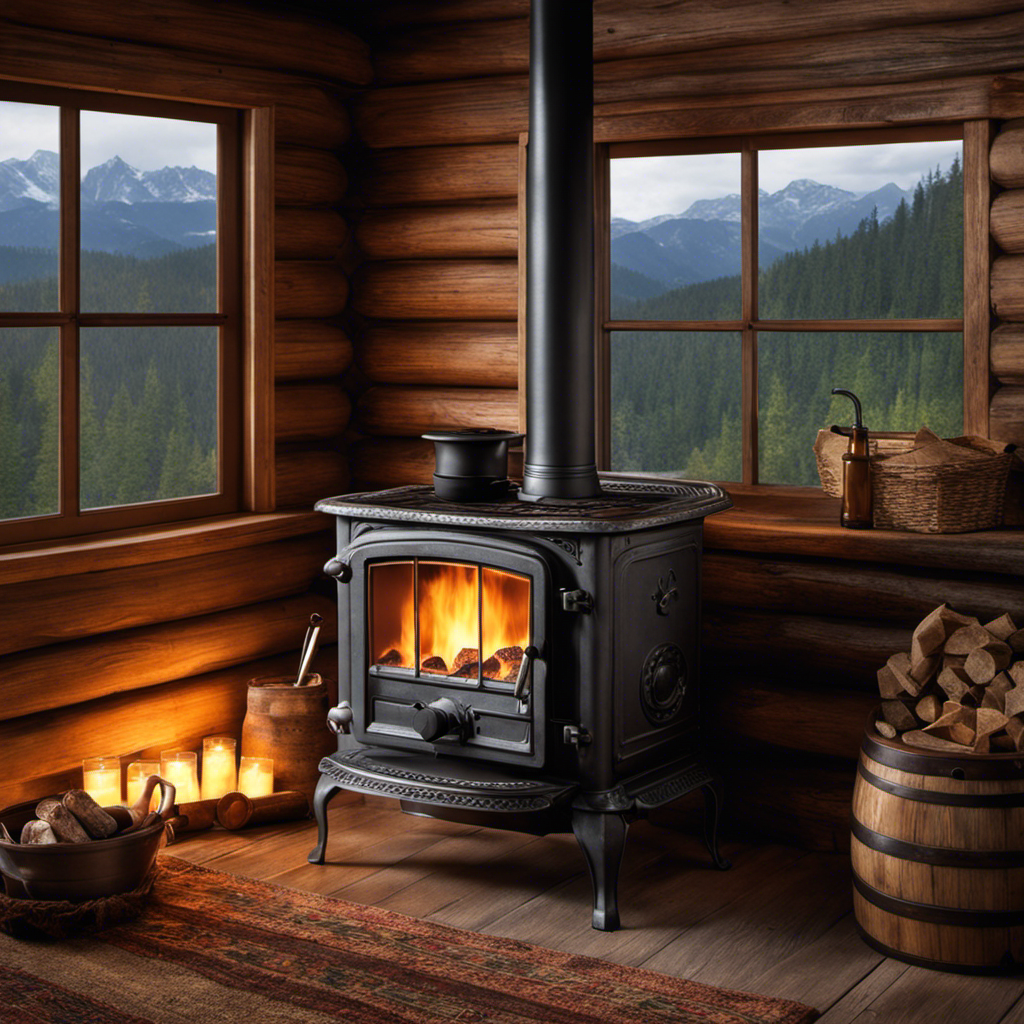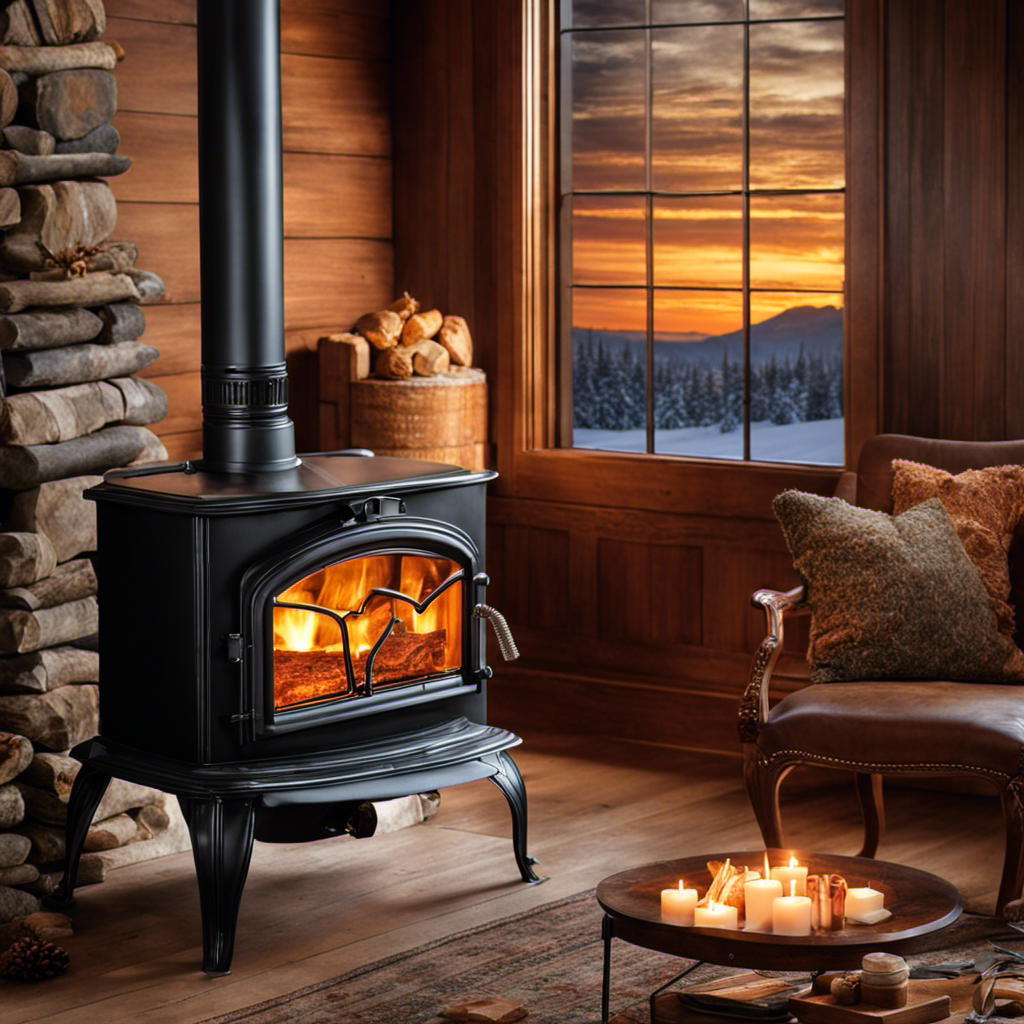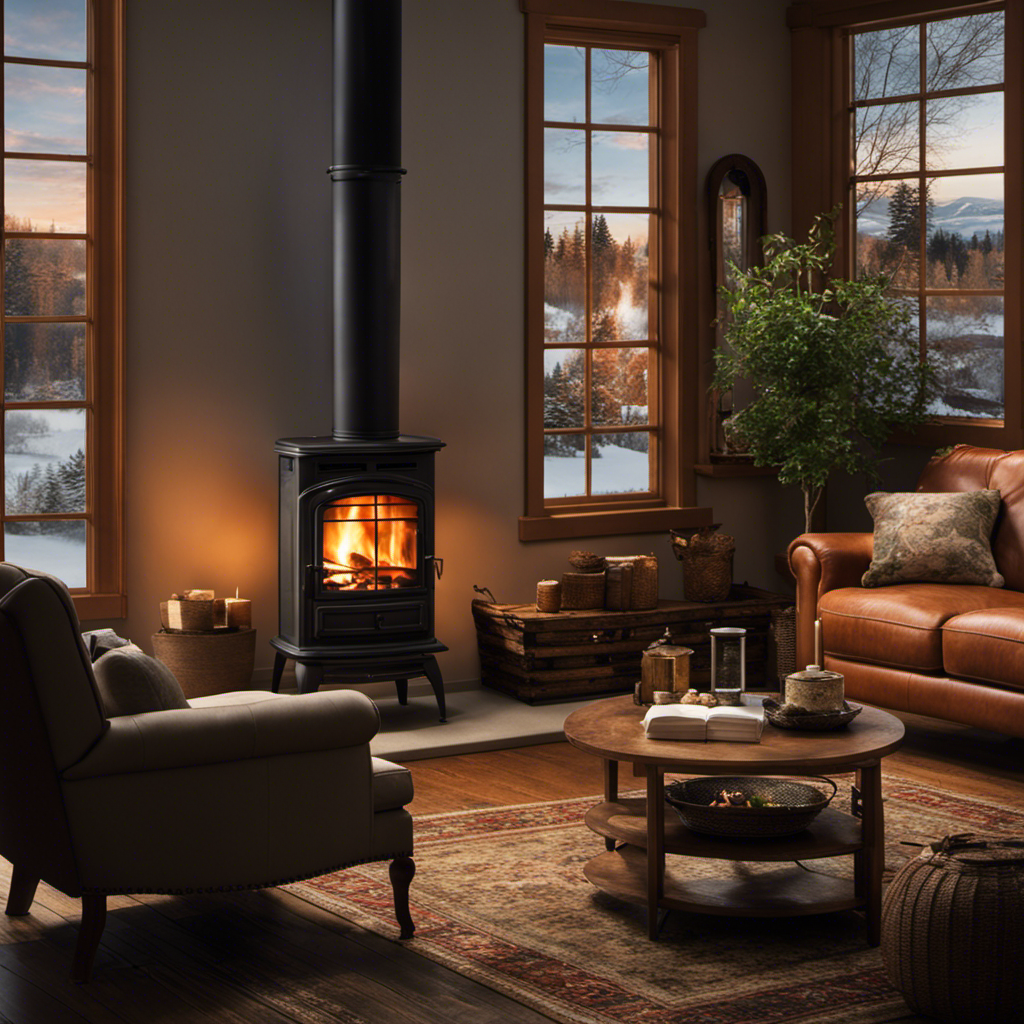As someone who loves snuggling up by a wood stove, I’ve always pondered, ‘What’s the shelf life of a wood stove?’ Let me spill the beans: it actually hinges on several crucial elements.
In this article, we’ll explore the average lifespan of different types of wood stoves and delve into the signs that indicate it may be time for a replacement.
I’ll also share some valuable tips for extending the lifespan of your beloved wood stove.
So, let’s get started and ensure your wood stove stands the test of time!
Key Takeaways
- The lifespan of a wood stove can be affected by factors such as the quality of materials used in construction, overloading the stove with too much wood, burning wet or unseasoned wood, improper installation, and lack of proper ventilation.
- The average lifespan of different types of wood stoves can vary depending on the quality of the stove itself, the frequency and effectiveness of maintenance, improper installation, over-firing, and neglecting routine maintenance.
- Signs that a wood stove may need replacement include excessive smoke during operation, cracks in the stove, difficulty maintaining a consistent temperature, decreased efficiency and increased air pollution, and leaks and reduced heat output.
- To extend the lifespan of a wood stove, it is important to use dry and seasoned firewood, maintain proper air flow, clean the stove and chimney regularly, avoid overloading the stove, and avoid burning trash or plastics. Additionally, regular cleaning to remove creosote buildup, avoiding overloading the stove with firewood, using dry and seasoned firewood, following manufacturer’s guidelines and recommendations, and ensuring proper ventilation and operation of dampers can help prolong the lifespan of a wood stove.
Factors Affecting the Lifespan of a Wood Stove
I’ve noticed that regular cleaning and proper maintenance are key to extending the lifespan of my wood stove. There are several factors that can influence the longevity of a wood stove.
One important factor is the quality of materials used in its construction. High-quality stoves made from durable materials like cast iron or steel tend to last longer than those made from cheaper materials.
Another factor is how the stove is used. Overloading the stove with too much wood or burning wet or unseasoned wood can cause excessive heat and stress on the stove, leading to failure over time.
Other common causes of wood stove failure include improper installation, lack of proper ventilation, and neglecting regular maintenance tasks like cleaning the chimney and inspecting the stove for any signs of wear or damage.
Average Lifespan of Different Types of Wood Stoves
I’ve noticed that while the average lifespan of different types of wood stoves may vary, regular maintenance and proper usage can significantly prolong their durability.
When it comes to the longevity of modern wood stoves, it’s important to consider several factors.
First, the quality of the stove itself plays a crucial role. High-quality materials and craftsmanship can ensure a longer lifespan.
Second, the frequency and effectiveness of maintenance also affect how long a wood stove lasts. Regular cleaning and inspection of components like the chimney and flue can prevent buildup and potential damage.
Additionally, common reasons for wood stove failure include improper installation, over-firing, and neglecting routine maintenance.
Signs Your Wood Stove May Need Replacement
Based on my experience, if you notice excessive smoke, cracks in the stove, or difficulty maintaining a consistent temperature, it may be time to consider replacing your wood stove. These are common problems that can indicate the need for a new stove.
Excessive smoke can be a sign of poor combustion, which can lead to decreased efficiency and increased air pollution. Cracks in the stove can result in leaks and reduced heat output. Difficulty maintaining a consistent temperature can make it challenging to heat your home effectively.
When considering whether to replace your wood stove, it’s essential to weigh the benefits that wood stoves offer. Wood stoves provide a reliable and cost-effective heating option, especially in areas with ample wood supply. They can also create a cozy and inviting atmosphere in your home. Additionally, wood stoves can be a sustainable and renewable heating choice, as long as the wood is sourced responsibly.
Tips for Extending the Lifespan of Your Wood Stove
I find that regularly cleaning and properly maintaining my wood stove has significantly extended its lifespan. By following a few simple tips for improving wood stove efficiency and avoiding common mistakes, you can also prolong the life of your wood stove. Here are some key tips:
| Tips for Improving Wood Stove Efficiency | Common Mistakes to Avoid |
|---|---|
| Use dry and seasoned firewood | Overloading the stove |
| Maintain proper air flow | Burning trash or plastics |
| Clean the stove and chimney regularly | Neglecting regular maintenance |
Using dry and seasoned firewood is essential for efficient burning and preventing excess smoke and creosote buildup. Proper air flow is crucial for efficient combustion, so make sure to adjust the damper and air vents accordingly. Regularly cleaning the stove and chimney will help prevent dangerous creosote buildup and ensure optimal performance.
Maintaining and Caring for Your Wood Stove to Prolong Its Lifespan
Regularly cleaning and properly maintaining my wood stove, along with using dry and seasoned firewood, can significantly prolong its lifespan. Here are some tips for cleaning a wood stove and common mistakes to avoid when using one.
Firstly, it’s important to clean your wood stove regularly to remove any creosote buildup. Creosote is a highly flammable substance that can accumulate in the chimney and stovepipes, increasing the risk of a chimney fire. To clean the stove, make sure it’s cool and remove any ashes and debris from the firebox. Use a wire brush to scrape away any stubborn deposits and vacuum the stove to remove any remaining dust.
Another important tip is to avoid overloading the stove with firewood. Burning too much wood at once can lead to excessive heat, which can damage the stove’s components. Instead, aim for a moderate and consistent burn.
Additionally, be mindful of what you burn in your wood stove. Avoid burning wet or green wood, as it produces more creosote and reduces the stove’s efficiency. Instead, use dry and seasoned firewood, which burns cleaner and provides more heat.
Lastly, always make sure to follow the manufacturer’s guidelines and recommendations when using your wood stove. This includes using the designated type and size of firewood, properly operating the dampers, and ensuring proper ventilation.
Frequently Asked Questions
Can I Use My Wood Stove for Cooking as Well as Heating?
Yes, you can use a wood stove for cooking as well as heating. Wood stove cooking tips include preheating the stove, using cast iron cookware, and adjusting the damper for temperature control. The benefits of using a wood stove for cooking include the delicious flavor it adds to your meals.
What Are Some Common Mistakes That Can Shorten the Lifespan of a Wood Stove?
Common mistakes like not cleaning the chimney regularly and using improper fuel can shorten the lifespan of a wood stove. Regular maintenance, such as cleaning and inspecting the stove, can help prolong its life.
Are There Any Safety Precautions I Should Take When Using a Wood Stove?
When using a wood stove, it’s important to take safety precautions. Ensure proper ventilation, keep flammable materials away, and use a fire extinguisher nearby. Regular maintenance, like cleaning the chimney, can also extend its lifespan.
Can I Use Any Type of Wood in My Wood Stove, or Are There Specific Types That Are Better?
I can use any type of wood in my wood stove, but there are specific types that are better. Hardwoods like oak and maple burn longer and produce more heat. They are also cleaner and create less creosote buildup, reducing the risk of chimney fires.
How Often Should I Have My Wood Stove Professionally Inspected and Serviced?
I recommend scheduling professional inspections and services for your wood stove at least once a year. While you may be able to maintain and service it on your own, having a professional check ensures safety and efficiency.
Conclusion
In conclusion, the longevity of a wood stove depends on various factors such as maintenance, usage, and the type of stove.
While there’s no definitive answer to how long a wood stove can last, proper care and regular maintenance can significantly extend its lifespan.
By identifying signs of wear and tear and taking necessary steps to address them, you can ensure your wood stove continues to provide warmth and comfort for many years to come.
Growing up surrounded by the vast beauty of nature, Sierra was always drawn to the call of the wild. While others sought the comfort of the familiar, she ventured out, embracing the unpredictable and finding stories in the heartbeat of nature.
At the epicenter of every remarkable venture lies a dynamic team—a fusion of diverse talents, visions, and passions. The essence of Best Small Wood Stoves is crafted and refined by such a trio: Sierra, Logan, and Terra. Their collective expertise has transformed the platform into a leading authority on small wood stoves, radiating warmth and knowledge in equal measure.











